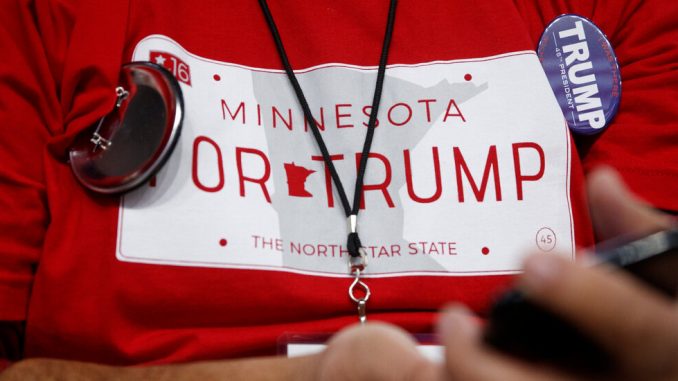
In his winning run for the presidency in 2016, Donald J. Trump came tantalizingly close to taking Minnesota, falling just 1.5 percentage points shy of Hillary Clinton in a state that seemingly loves to break Republican hearts.
On Friday, the former president was back, speaking at a fund-raising dinner for the Minnesota Republican Party in St. Paul that was open only to paying guests and invited media. Whether the visit is a feint to draw Democratic dollars to the state or a true effort to expand the electoral map, only the Trump campaign knows.
But it is a moment to look at the stark divisions in a state where the urban and rural political and social gulf is particularly vast.
“Nobody lives this stronger than I do,” said Representative Angie Craig, a Democrat whose swing district, maybe the last in the state, runs from the southern edges of Minneapolis and St. Paul into rural areas southeast of the cities. “Look, I was on the ballot in 2016 when Trump first ran. He won my district, and I lost my race. We’re all going to have to work really, really hard this year.”
Minnesota has not voted for a Republican presidential candidate since Richard M. Nixon won the state in 1972. But Mr. Trump’s share of the vote actually rose from 2016, when he won 44.9 percent and Ms. Clinton took 46.4 percent, to 2020, when the former president won 45.3 percent and President Biden won 52.4 percent.
Republicans in the state insist 2024 is their year.
“Minnesotans are hard-working, blue-collar Midwesterners, and they are being crushed by the policies of this administration,” said Representative Pete Stauber, a Republican who in 2018 flipped a Democratic seat that covers a vast swath of Northeast Minnesota, including its iron range. “Those 10 electoral votes are going to go to President Donald Trump.”
Some Democrats are worried. Representative Dean Phillips, a Democrat who represents the affluent, educated suburbs west of Minneapolis that for years voted Republican, then switched to him, said he had been surprised by the number of constituents he has spoken to who are ready to vote for Mr. Trump. Mr. Phillips challenged Mr. Biden for the Democratic nomination and got nowhere. Now he wants to see the president re-elected.
“I don’t think Trump would be spending his precious time coming to that event, in the Twin Cities mind you, if his campaign didn’t have some good internal numbers,” Mr. Phillips said.
No Republican has won a statewide election since 2006, but the Democratic winning streak does not capture the complicated dynamics of a state where the urban core, Minneapolis-St. Paul and its suburbs, has grown sharply in population and noticeably leftward, while rural Minnesota has moved to the right.
The defeat of Representative Collin Peterson, the 15-term moderate Democrat and leader of the House Agriculture Committee, in 2020, and the retirement of Rick Nolan in 2018, who was replaced by Mr. Stauber, swept away the last remnants of Democratic centrism in the vast northern reaches of the state. The largely rural southern Minnesota district once represented by the state’s Democratic governor, Tim Walz, now has a conservative Republican entrenched as its congressman.
Meantime in Minneapolis, the Democratic Socialists of America and their allies secured a majority on the City Council last year. The suburbs, once dominated by moderate Republicans, have moved to the Democrats.
The Trump campaign believes it can capitalize on — or foment — a backlash to the leftward march of the Twin Cities and still-fresh memories of the unrest after the killing of George Floyd.
“Very sad what’s happened to your state,” Mr. Trump told a newscaster on the conservative website Alpha News on Thursday, attacking Minneapolis’s progressive Representative Ilhan Omar as a “hater,” promising “mass deportations” and vowing “to bring back the law enforcement the way it was” before Mr. Floyd’s murder. “Your state is out of control, and it’s this radical left philosophy that cannot be left to continue.”
Recent polling has Mr. Biden clinging to a narrow lead in Minnesota, inside some polls’ margins of error. His tenuous position has been exacerbated by the war in Gaza. A protest campaign for “uncommitted” in the Democratic presidential primary in March drew 19 percent.
“We have a real opportunity to expand the map here,” Chris LaCivita, a senior Trump campaign adviser, told The Associated Press ahead of Mr. Trump’s visit.
Even Democrats in the state have their worries.
“In the end, I don’t really think Minnesota will be in play, in part because when the contrast between a completely unhinged Donald Trump and Biden crystallizes toward the end of the campaign, disaffected and undecided voters here will turn out for President Biden,” said Jim Manley, a Democratic political consultant who lives in Minneapolis. “But it’s going to be too close for comfort.”
Mr. Phillips said, “I confess to have spoken to more people, and some remarkable people, who say they will vote for Trump. Many will, and many more than will admit it.”
That said, Minnesota has been to Republicans what North Carolina has been to Democrats. They can see how to win it. They have won it in the past. But they always seem to come up short. Barack Obama won North Carolina in 2008. Tim Pawlenty, Minnesota’s last Republican governor, barely won re-election in 2006.


Be the first to comment